Operators are cashing in on the rise of blended travel






Operators are cashing in on the rise of blended travel





When you examine the topic of sustainability, it becomes clear that despite our best efforts to focus on it, real progress has taken too long. Specifically, when you look at efforts in the hotel industry, it’s clear that companies such as Fairmont Hotels & Resorts have been leaders in this field for quite some time — dating back, in fact to its previous iteration when the company was part of Canadian Pacific Hotels & Resorts. And, while many other hotel companies have followed suit in recent years, introducing various greening initiatives along the way and making great inroads, we can’t attain a true measure of success at the hands of a few companies to truly make a significant impact, we have to be all in.


While the simple mantra of the three R’s: reducing, re-using and recycling apply more today than ever, we need to become comprehensive in our efforts. To truly be sustainable, we need to focus on all elements of our infrastructure from transportation, to the energy we use, to our water supply, to waste not just food waste but also water and energy waste right down to the design of the hotel. We need to focus on the products we use in every hotel department, we need to ensure that we reduce our carbon footprint and we need to treat our oceans and lakes with the respect they deserve. The only way to accomplish these goals is to ensure your business has a sustainability strategy in place and to provide practical steps that are easy for staff to follow while partnering with like-minded suppliers who will help you in your quest.
Not only is going green the right thing to do, but as columnist Cayley Dow so aptly explains in this month’s column (see page 9), “Companies that prioritize corporate governance (ESG) are more successful in attracting and retaining great talent,” which is more important than ever given pervasive labour shortages. She cites a report from Mercer that found that one in four employees admit they would quit if their employer had a poor sustainability record. In fact, Dow states that more than 40 per cent of Canadian youth between the ages of 16 and 25 report that climate anxiety is affecting their daily functioning, and therefore employees are increasingly looking for aligned companies that are actioning a sustainable future.
But let’s not forget that to succeed on the sustainability front, we need to better understand that the word has taken on a broader context. Granted, to be true environmental stewards, it behooves us to care about the planet to ensure its survival and to succeed we need to focus on all the points cited above. But equally important is paying staff living wages so they can have a sustainable future, treating them equitably, being inclusive, and giving them a voice.
NB: After several years of hiatus, Kostuch Media Ltd., is proud to once again present its annual Green Leadership Awards at our Top 30-under-30 Leadership Summit, scheduled for June 13th at the Sheraton Centre Toronto Hotel.
ROSANNA CAIRA Editor & Publisher
AMY BOSTOCK Managing Editor
NICOLE DI TOMASSO Assistant Editor
COURTNEY JENKINS Art Director
JENNIFER O'NEILL Design Assistant
TYLER BECKSTEAD Web Manager
JANINE MARAL Social Media Manager
WENDY GILCHRIST Director of Business Development
CATHI KREWICKI Account Manager
KIMONE CLUNIS Sales & Marketing Assistant/Events Co-ordinator
DANNA SMITH Administrative Assistant
DANIELA PRICOIU Accounting Services
CIRCULATION PUBLICATION PARTNERS kml@publicationpartners.com
Andrew Weir, Destination Toronto; Anne Larcade, Sequel Hotels & Resorts; Anthony Cohen, Cresent Hotels — Global Edge Investments; Bonnie Strome, Hyatt Hotels; Christiane Germain, Germain Hotels; Don Cleary, Marriott Hotels; Gopal Rao, Conestoga College; Hani Roustom, Friday Harbour Resort; Laura Baxter, Co-Star Reetu Gupta, Easton's Hotels; Ryan Killeen, The Annex Hotel Ryan Murray, The Pillar + Post Hotel; Stephen Renard, Renard International Hospitality & Search Consultants
HOTELIER is published eight times a year by Kostuch Media Ltd., Mailing Address: 14 – 3650 Langstaff Rd. Ste. 33, Woodbridge, ON L4L 9A8, (416) 447-0888. Subscription rates: Canada: $25 per year, single issue $4, U.S.A.: $30 per year; all other countries $40 per year. Canadian
Publication Mail Product Sales Agreement #40063470. Member of Canadian Circulations Audit Board and Magazines Canada. Printed in Canada on recycled stock.

All rights reserved. The use of any part of this magazine, reproduced, transmitted in any form or means, or stored in a retrieval system, without the written consent of the publisher is expressly prohibited and is an infringement of copyright law.
Copyright, Hotelier 2023 ©
Return mail to: Publication Partners 1025 Rouge Valley Dr., Pickering, Ontario L1V 4N8



This is very positive for the Fairmont brand because it’s continuing to grow and has dedicated resources again. I feel very, very positive about the whole transition.
I’m confident of the new organization and feel it’s moving in the right direction
 BY ROSANNA CAIRA
BY ROSANNA CAIRA
After a renowned career spanning more than four decades and various hotel roles and responsibilities, Heather McCrory, will be stepping down from her role as CEO, North and Central America, Accor at the end of May. The move comes after a major re-organization at Accor was announced last year and implemented this past January, which will see Accor create two new divisions in the global company and shift operation of its luxury brand, the Fairmont Hotels & Resorts to Dubai.
For McCrory, who will be marking her 40th anniversary at the company in May the journey started in the Laundry department at the Banff Springs Hotel, when it was part of CP Hotels and rose through the ranks in Sales & Marketing and Operations before moving into the C-Suite the decision to leave is bittersweet but she’s looking forward to new opportunities and affirms she is not retiring.
In an interview with Hotelier recently, McCrory said, “As part of the re-organization, I will be leaving Accor after the transition period, at the end of May 2023. The month of May brings a significant career milestone for me, 40 years with Accor/FRHI/Fairmont/Canadian Pacific Hotels, and the timing seems right for a change. The hospitality industry continues to inspire me and I'm excited for the next chapter and have comfort in knowing I’m leaving the organization in very capable hands.”
McCrory says Accor’s structural shift is significant and was the impetus for leaving the company. But she also says, given the increasing globalization of the industry and the desire to strengthen the brands, the move is very strategic for Accor. “Six years ago, we were purchased by Accor and Fairmont was blended into the global organization. The company was in a growth period at that time, in terms of number of brands. The new global structure provides Accor’s luxury brands and hotels with the focus, attention, specialized talent and expertise needed to build on Accor's position as the second-largest luxury and lifestyle hospitality company in the world and it also allows for dedicated resources for the continued growth of our "power brands” eco, midscale and premium. In North America, this gets a little bit more complicated; we have worked through the transition of re-organizing into a brand-lead organization for Raffles, Fairmont, Sofitel, Lifestyle and the Eco Midscale hotels.
“This is very positive for the Fairmont brand because it’s continuing to grow and has dedicated resources again. I feel very, very positive about the whole transition. I am confident of the new organization and feel it’s moving in the right direction. From that perspective, it’s very positive,” says McCrory.
McCrory says Mark Willis, the new CEO of Fairmont, “will bring a tremendous amount to the table, particularly to grow the Fairmont brand and to rejuvenate, re-energize the Fairmont brand and take it to the next level.” ◆
Hyatt Hotels Corporation has unveiled Hyatt Studios, the newest addition to its portfolio of brands, marking its entry into upper-midscale lodging in the Americas. This unveiling is supported by signed letters of interest in development agreements from multiple developers for more than 100 Hyatt Studio hotels, with construction expected to begin in 2023 and the first hotel expected to open in 2024. Hyatt Studios will be led by industry veteran Dan Hansen, who has served as strategic advisor throughout the brand’s conception.
The brand prioritizes scalable construction options and an efficient operating model designed to adapt to local needs across primary, secondary and tertiary markets alike. The brand is also designed to be flexible based on developer needs, accommodating both extended-stay and shorter-stay leisure and business transient guests depending on the hotel’s market and guest base.

Hyatt Studios will join the Hyatt Place, Hyatt House and Caption by Hyatt brands in the select service category, offering Hyatt’s signature guest experience with self-serve amenities and in-room offerings. Guestrooms will offer suites with kitchen amenities to provide comfort during extended trips away from home. The Hyatt Studios food-and-beverage experience will include a complimentary grab-and-go breakfast and a 24-hour market.
“As with all brands in the Hyatt portfolio, Hyatt Studios hotels will appeal to the high-end guest within its segment,” says Amy Weinberg, senior vice-president, Loyalty, Brand Marketing & Consumer Insights. “Amidst a sea of interchangeable extended-stay competitors, Hyatt Studios hotels will transcend dated notions of value-driven compromise by inviting guests to enjoy both the coziness of a studio apartment and the positive energy of being in a creative studio, all with the quality and contemporary style that is characteristic of Hyatt.”
The Coast Bastion Hotel in Nanaimo, B.C. has unveiled its plans for guestroom renovations, set to begin in late November. These renovations will offer guests an elevated refreshingly local experience with a focus on comfort, intuitively designed rooms and suites and unparalleled service. The re-design will also incorporate modern technology, allowing guests to enjoy seamless connectivity during their stay.
The project will include updates to every guestroom and suite, including new furnishings, bedding and fixtures. The design incorporates a fresh and modern feel, featuring neutral colour palettes with pops of rich blue, paying homage to the property’s scenic oceanfront location.
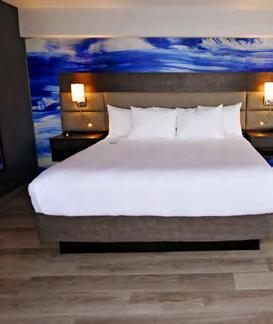
“We are thrilled to be embarking on this renovation project,” says David McQuinn, general manager, Coast Bastion Hotel. “We aim to provide our guests with an even more exceptional experience when they stay with us, from the moment they arrive until the time they depart. These new renovations will allow us to do just that.”
The renovations will be completed in phases to minimize any disruption to guests. During this time, the hotel will remain open.
Felicia Mongelli has been promoted to director of Sales, and Victoria Simmons to director of Room Operations, at the Westin Harbour Castle, Toronto. The promotions will see these two new leaders guide the Sales and Operations departments as the hotel begins its renovation journey.
In her new role, Simmons will oversee the new room operations at a time when the hotel’s guestrooms are being renovated. Previously, she was director of Event Planning. Simmons has spent her entire career at the Westin Harbour Castle, Toronto working in progressive leadership roles, including Banquets assistant manager, assistant director of Banquets, stewarding manager, assistant director of Housekeeping and director of Banquets.
Mongelli, on the other hand, is an award-winning sales executive who won the President’s Circle Award and continuously exceeds her revenue targets. Previously, Mongelli was the senior sales executive at the hotel. She started her career with Marriott in 2000 at the Sheraton Parkway Toronto North Hotel as a front desk and lead reservation agent. In 2004, she began various roles in the sales department.

“I’ve experienced many hotel renovations at the various properties I’ve worked at and understand how important it is to have a steadfast leadership team to guide our associates and guests through upcoming changes,” says Peter Gilis, GM at the Westin Harbour Castle, Toronto. “Victoria and Felicia are the right people to lead these teams. I know they will further strengthen our hotel and better prepare us for our future.”
Sageblan Investments Inc. has changed its name to Artifact Group Inc. The new name signifies the company’s commitment to timeless design, craftsmanship and enduring value.
“We consider our properties to be valuable treasures, and ‘Artifact’ better describes our commitment to detail and quality,” says Gaurav Gupta, president, Artifact Group. “While our name is changing, our dedication to providing exceptional service for our guests, while prioritizing the well-being and growth of our employees as we continue to identify, acquire, and re-new properties remains steadfast. We look forward to continuing to create thoughtful and inspired spaces that stand the test of time under our new name.”

Marriott International has launched its new people brand, Be, as the company continues its focus on attracting and retaining top talent around the world. Be will highlight the vast opportunities within Marriott, from hotel operations and food and beverage, to sales and marketing, systems engineering and tech roles.
Marriott’s Be brand will launch globally across its portfolio of more than 8,300 properties and 30 brands. The brand will focus on three distinct pillars: begin, belong and become. With the goal of attracting and retaining top talent, Be will empower associates to fulfill their career goals, further Marriott’s commitment to creating a culture of inclusion and offer innovative opportunities to grow professionally and personally.

“For over 95 years, Marriott has been committed to creating a culture of putting people first,” says Anthony Capuano, president and CEO of Marriott International. “As we focus on strengthening our culture, expanding our global workforce, and positioning the company for continued growth, we are excited to build on our people-first culture with Be. We are proud to be an employer of choice for hundreds of thousands of associates who wear the Marriott name badge around the world. Be will help us fulfill our purpose of connecting people through the power of travel by empowering and supporting our associates.”
As global travel continues to remain strong, Marriott added over 200,000 associates around the world in the past year. The company is continuing to invest in and grow its workforce in 2023, offering competitive pay, benefits and rewards, flexible scheduling, an increased retirement savings plan match, a newly introduced Employee Stock Purchase Plan for U.S. and U.S. Virgin Islands associates, and discounted travel across 30 hotel brands in the Marriott Bonvoy portfolio.
Atlific Hotels’ managed property, The Simon Hotel Sydney, has completed extensive renovations to its 144 guestrooms, suites and public spaces, along with a fresh new brand concept reflecting these updates.

With a nod to owner Irwin Simon, who was born and raised in Cape Breton, this re-launch serves as a way of celebrating his native city after a successful 30 plus years (as the former Cambridge Suites Hotel Sydney). Renovations of the hotel’s lobby, restaurant and bar, guestrooms, corridors, rooftop patio, meeting rooms and fitness centre were led by Royal Design Inc. who took inspiration from the property’s waterfront location as well as the casual and relaxed vibe that Sydney is known for.
The hotel’s 144 guestrooms and suites were designed with a focus on clean lines, modern finishes and muted taupe and blue tones to carry the nautical theme home. Streamlined design features such as new vanities and mirrors with lighting tie everything together. Guests can choose from a variety of room configurations suited to their needs, from standard rooms geared to short stays, to spacious one-bedroom and harbour view guest suites offering a separate living and bedroom along with a birds-eye view of the waterfront. Those looking for added amenities and services will enjoy all-new Skyline Executive Floor offering a special welcome amenity, complimentary breakfast delivered to your suite, luxurious bathrobes, upgraded
bath towels, upgraded bath amenities, Keurig coffee machine, bottled water and in-room Bluetooth speaker. The crown jewel of the collection is the 1,100 sq.-ft., sun-drenched, Simon Suite offering two-bedrooms, two full bathrooms, an oversized fireplace, dining area and views of Sydney Harbour.
The renovations also reconfigured the lobby and TRIO Restaurant, creating an open-concept area that invites socializing and is easily accessible throughout the day. New flooring throughout the lobby leads up to a freshly installed lobby market and welcoming front-desk pods. In TRIO and the hotel lobby, communal tables were incorporated, serving as a place where guests can have a drink, work or host an informal meeting in a relaxed setting. Glamorous finishes round out the dining area as a nod to TRIO’s reputation as one of the best restaurants in the city.
AFAR magazine has revealed its list of the world’s best new hotels of 2023, which includes Muir hotel, located on the edge of the Halifax Waterfront.
Since opening in December 2021, Muir has welcomed travellers to a refined, distinctly Nova-Scotian experience inspired by the region’s rich cultural history, raw and physical beauty and enduring character. “Muir tells the story of who we are from the expression of place found throughout Muir’s art and design to cuisine inspired by our land, people, and history, to our elevated East Coast hospitality and service,” says Eugénie Jason, general manager, Muir. “It means a great deal to be selected as one of AFAR‘s best new hotels for 2023. It allows us to extend an invitation to travellers from around the world interested in forging an authentic connection with our region.”
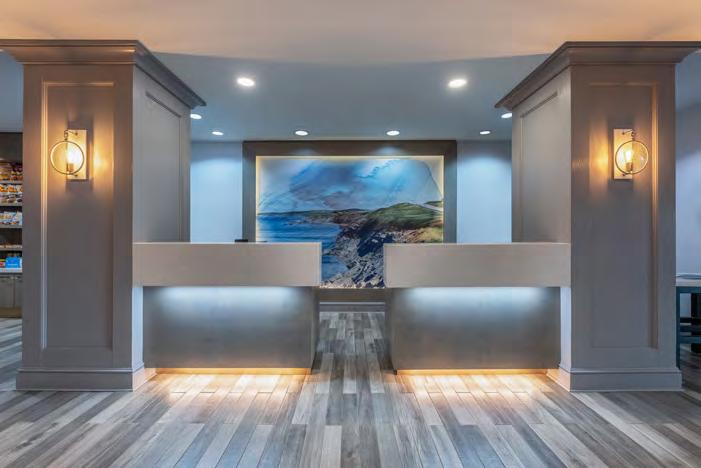
, I waited nervously at the Calgary airport for the Brewster bus to arrive and take me to the remote Rocky Mountain resort. That trip would change the course of my life. I never expected one summer internship would turn into a decade of career building, adventure, and form a deep sense of connection to this pristine “place.”
Over the years, I saw my “place” devastated by forest fires, floods and extreme weather events that sparked my anxiety over our changing climate. I’m part of the growing majority, where concerns over a sustainable future have become engrained in my values, and therefore my desire to choose a career with real impact.
Companies that prioritize corporate governance (ESG) are more successful in attracting and retaining great talent. A recent report from Mercer found that one in four employees admit they would quit if their employer had a poor sustainability record. Furthermore, in March 2023, the UN climate panel released ground-breaking information stating that global warming is poised to irreparably alter the livability of current and future generations, if not acted upon now. With more than 40 per cent of Canadian youth between the ages of 16 and 25 now reporting that climate anxiety is affecting their daily functioning, employees are increasingly looking for aligned companies that are actioning a sustainable future.
Barbara Ward once said, “We have forgotten how to be good guests, how to walk lightly on the earth as its other creatures do.” Being a “good guest” of the planet is more than embedding sustainability as part of the employer brand. It means proving that sustainability efforts are for impact, not optics or a greenwashing scheme. How?
Start by making the most senior leader the ESG champion to
amplify the message and the culture. Measure performance using the triple-bottom-line approach, which looks beyond just profit to the “three Ps” profit, people and the planet. Honest and transparent reporting of this data proves to future and current employees the commitment to making a difference comes from the top.
Reduce your operation’s carbon footprint by offering cyclingto-work incentives, installing solar panels, and enabling work from home where possible. Install or subsidize employee EV charging stations. Enable people to properly re-use, recycle and divert waste, and become paper free by implementing software needed to digitize the business.
Partner with stakeholders who share common ESG values, and who will aid to advance your sustainability goals. Support sustainable charitable organizations and offer annual paid leave for employee volunteerism.
The growing urgency for sustainability means that consumers are choosing actions and experiences that prioritize environmental stewardship. It is pivotal for companies to solidify their commitment to sustainability if they’re to be successful in attracting and retaining the best talent while securing a healthy planet for future generations.
Cayley Dow is the Founder of Thrivity Inc. (thrivityhr.com), a human resources consulting and coaching firm that helps service-oriented businesses to thrive in the ever-evolving world of work.

Ahotel’s future can no longer be sufficiently bucketed into only leisure, corporate and groups. Hoteliers know this, but the obstacle nowadays is too much information. There are legacy systems that are difficult (and expensive) to integrate and lots of disjointed guest profiles also known as data silos. Nevertheless, the need for system consolidation and unified guest profiles, particularly at the enterprise level, becomes all the more critical with the renewed drive for customer segmentation.
Emerging segments abound. Bleisure is classically inscribed for business-primary guests who then extend their stay to see the area or experience a property’s amenities. Similar but different, workcations came to the limelight during the pandemic to describe those knowledge workers who can get their projects done remotely, oftentimes eschewing the home desk for a change of scenery at a nearby hotel. Then there are the straight-up digital nomads who have no office shackles and, as the name implies, prefer a more itinerant lifestyle.
These trends are reaching the mainstay at the exact moment that hotels need more guests. While there are many stats showing that travel numbers for 2023 will defy the economic gravity of a recession, the reactionary throttling of household discretionary spending namely vacations tends to only

reveal itself as a lagging indicator. Meanwhile, midweek occupancies aren’t looking as good as companies are loathed to give up the huge cost savings from the video-conferencing boom by returning to the days of overly generous corporate travel budgets.
Regardless, the overarching trend for the rest of the decade is that travel experiences are more widely valued across all demographics in the post-pandemic world, but guest behaviours and guest demands have both undergone radical shifts. Brand loyalty is eroding and top-of-funnel marketing is more expensive, meaning more attention must be given to specific psychographic targeting in order to tap into market niches. Further, with operational costs going up, hotels must drive more revenue per guest (TRevPAR) through packaging, upselling and cross-selling of amenities.
Stated differently, segmentation in this manner is to know your customer (KYC) more deeply in aggregate so that any hotel can optimize performance without cost overruns. Segmentation lets a brand identify the most fruitful sales channels, the highest TRevPAR guest types, opportunities to anticipate service requests and agile, cost-effective marketing tactics.
Here are some examples of how tech-driven segmentation can help you optimize revenues:
• If you use OTAs, do you devote the advertising budget to Expedia or Booking when the former produces more bookings but, in analyzing your internal systems, the latter has a longer length of stay (LOS) and more significant F&B spend at the restaurant?
• How about a peak summer weekend at a seasonal property that has sold out in the past with high-TRevPAR leisure couples, and this year the sales manager has brought forward a wedding RFP where the group occupancy is guaranteed but the actual per-guest spend may be lower.
• Suppose you want to develop a wine-lover package that’s exclusive to past guests who have been identified as such via past package purchases, welcome amenity purchases or restaurant spend history, yet how would you do this nimbly if your POS data isn’t currently cleaned and merged with guest profile data from the PMS, CRS, or GEMS?
To get accurate predictions for these sorts of differential segment-versus-segment situations, the data integrations into one central storehouse become an ever-critical and ongoing task to complete these calculations in a timely and labourlight manner.
Bleisure is an even tougher nut to crack because you are trying to change the standard business traveller behaviour of arriving, focusing on the work then departing as quickly as
possible. Conquering this obstacle requires contextual data that is, the how and when behind your conversion funnel.
For instance, a business guest makes a reservation two months prior to the date of arrival but only opens your room upgrade offer message that’s sent seven days out. Or maybe your automated pre-arrival email-based upselling isn’t working, but SMS offers sent out three days prior are converting.
Testing for, then getting differential context like this requires a lot of well-oiled techs to do without overloading your reservations or revenue teams. But the benefits are long-lasting. If you can start by figuring out the bleisure segment and what compels these guests to buy, then you can apply the same methods and systems to solving any other segment.
Above all, we stress that the future of hotel operations will progressively be influenced by the hunt for greater and greater TRevPAR and more granular KYC in order to microtarget specific audiences. Bleisure is a great place to start for this grand goal because it will help drive mid-week and off-peak revenues, both places where most hotels could use a little boost.
Larry and Adam Mogelonsky are partners of Hotel Mogel Consulting Limited. You can reach Larry at larry@hotelmogel.com or Adam at adam@hotelmogel.com

Hotelier’s annual Top 50 Report, highlights the industry’s leading performers for 2022. It’s been a crippling few years for Canada’s hotel industry, adding new twists to an already challenging landscape. Find out who the industry’s leading performers are and how they’ve dealt with the ramifications of the pandemic.
• Trends: the New Era of Business Meetings
• Decor & Design: Innovation in Design

• Operations: Locally Curated Amenities
• Equipment/ Technology: Self-Serve Kiosks
• F&B: Developing a Successful Beverage Program
 BY NICOLE DI TOMASSO
BY NICOLE DI TOMASSO
It’s no secret that the bleisure traveller has re-emerged. The human desire for exploration, combined with a work-fromanywhere revolution, has blurred the boundaries between work and play. As the name implies, bleisure travellers are either arriving a few days before work-related commitments or extending their stay a few days after to unwind, spend time with loved ones or
experience local attractions. As many people continue to work remotely, the number of bleisure travellers is expected to stay steady in 2023, so hotels that focus on bleisure travel, and increase their efforts to attract it, will be greatly impacted.
In April 2022, the Global Business Travel Association (GBTA) surveyed members and industry stakeholders involved in managing or procuring travel
for their company. In the results, 90 per cent of respondents said employees are more (30 per cent) or equally (60 per cent) as interested in bleisure travel compared to pre-pandemic times. Only 10 per cent said employees are less interested in blended travel. Similarly, one study of global business travellers found 89 per cent wanted to add a private holiday to their business trips in the next 12 months, according to the American Hotel &

Lodging Association’s (AHLA) State of the Hotel Industry Report 2022.
Typically, bleisure travellers fall into two main categories: extended solo business travel and business travel with friends or family. While all generational cohorts have engaged in bleisure travel, it’s believed that millennials and Generation X have led the way in normalizing the trend as the pandemic pushed many Baby Boomers into premature retirement.
To better accommodate and attract bleisure travellers, hotels must ensure their properties offer amenities and services that bleisure travellers require. Most importantly, this group need plenty of in-room workspace, meeting-room availability and a stable Wi-Fi connection. Adding small conveniences, such as free coffee, improves the guest experience. Additionally, bleisure travellers appreciate digital touchpoints, such as branded mobile apps, mobile check-in and checkout, mobile keys or in-room tablets. As a result, hotels drive customer loyalty, return visits and company margins.
Another way for hotels to attract this segment is to showcase their leisure amenities, such as a spa, swimming pool and sauna or gaming area, to promote relaxation and minimize work stresses. Lastly, bleisure travellers are willing to spend money on local experiences. Generally, bleisure travellers spend less time planning their bleisure trips than a traditional vacation, so they appreciate when hotels highlight nearby restaurants, attractions and other sources of entertainment in seamless ways. On that note, here are a few hotel companies that have positioned themselves to reap many bleisure travel benefits.
Marriott International is opening its 160-room Moxy Halifax Downtown later this year, marking the first Moxy hotel in Canada. Instead of a traditional front desk, guests are welcomed at Bar Moxy where they will receive their room keys as well as a complimentary cocktail. The guestrooms are small, but expertly designed with plenty of outlets for electronics, a television, a foldable table and a full-size bathroom, while the hotel’s living room, games room, fitness centre, yoga room and library set the tone for a social experience. Additionally, the hotel features four event

rooms encompassing 1,520 sq. ft. of total event space, a meeting room and a tasting room. Moxy Banff is also expected to open later this year.
“Moxy is an unconventional brand, with a large focus on communal spaces,” says Aaron Laurie, VP, Lodging Development, Eastern Canada, Marriott International. “The communal spaces allow guests to check in but also provides opportunities for guests to work and play. From a revenue-per-square-foot standpoint, limited density sites allow developers to maximize room counts, which is more difficult to do under traditional hotel brands with larger guestrooms.”

Marriott also unveiled its latest extendedstay brand – Apartments by Marriott Bonvoy (AMB) – to target travellers who enjoy unique, local experiences. Unlike Marriott’s existing extended-stay brands, including Residence Inn, Towneplace Suites, Element Hotels and Marriott Executive Apartments, AMB will not provide traditional hotel services such as food and beverage, meeting space and retail. The concept will target both new-build and conversion opportunities, but Laurie says locations have not been released for the brand at this stage. “We’ve built upon our learnings from Marriott Executive Apartments, which we’ve had in our portfolio for decades, primarily in Europe, Asia and the Middle East,” says Laurie. “We’re applying a similar concept here in North America. Apartments by Marriott Bonvoy is a soft-branded hotel-serviced apartment concept, and allows developers to create their own unique design narrative for the hotel while simultaneously plugging into the power of Marriott. Similar to Marriott Executive Apartments, AMB offers apartment-style units with full kitchens, washers and dryers, and ultimately a lighter staffing model.”
Laurie continues, “AMB is different from Marriott’s existing extendedstay brands because it falls within our
premium to luxury positioning while the others are either upper midscale or upscale. Generally, the units at AMB will be larger and have a mix of one-, two- and three-bedroom units whereas our existing extended-stay brands are typically studio or one-bedroom units. AMB has a full kitchen and a washer and dryer whereas our existing extendedstay brands have a smaller kitchen and communal guest laundry.”
Similarly, Choo Communities, an Ottawa-based developer, has offered a new way to travel with the creation of reStays, a boutique hotel that combines luxury hotel accommodations with condo-like amenities. The property boasts 111 suites, including fully furnished studios, one-bedroom and two-bedroom apartments, as well as a series of signature collection suites. Hotel amenities include a private cinema room, SkyLounge, fitness centre, meeting room and sauna.
“Our suites are very different and particular in design. Where we are unique is that we are in a mixed-use building with 11 floors of condos that are privately owned, so it’s interesting to see how this co-exists,” says Andreas Spove, general manager at reStays. “The suites are laid out with full kitchens, including a freezer, fridge, stove, microwave and seating areas, as well as a washer and dryer. Some suites even have kitchen islands. The layout of our suites, in
addition to our amenities and residential common areas, makes reStays so much more than a traditional hotel stay.”
Meant for both short-term and long-term stays, reStays seeks to re-imagine travel by giving guests access to the reStayers Club, which includes perks and storage facilities for their belongings, making travel light and accessible. Additionally, reStays offers a fridge-filling service and private-chef dinners. This summer, reStays will introduce new balcony furniture, including bistro tables, sun loungers, cocoon swings, hammocks and firepits to allow guests to enhance their luxury experience.
“Our fridge-filling feature is a popular and appreciated added option for guests, especially if they’re arriving late,” says Spove. “They can choose exactly what they want from our curated list and we can ensure the fridge is stocked with those items upon a guests’ arrival. We can also organize to have private chefs from our curated partner chefs list come in and cook for [guests] in the intimacy of their own suite, which makes for a special and exclusive experience.”
Germain Hotels owns and operates Le Germain Hotels, Alt Hotels and Escad Hotels across Canada. All brands prioritize functionality when it comes to guestrooms and common spaces as bleisure travellers seek to maximize their productivity. In June, Alt Hotel Calgary
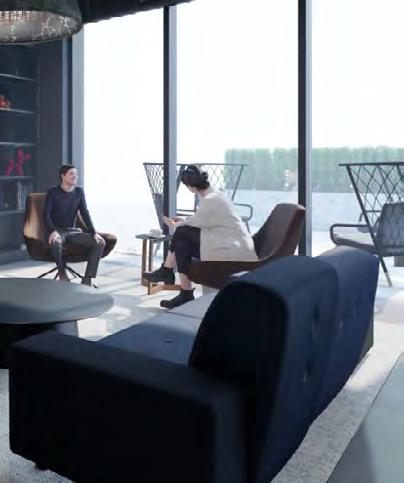

University District, managed by Nadia Gravel, will open. Some features that will cater to bleisure travellers at Alt Hotel Calgary University District include free Wi-Fi, 24-hour gym, Nespresso coffee machine, HD television with Chromecast device, workstation and more.


“The rise of the bleisure traveller is a trend we saw before COVID, but has since been accelerated,” says Marie Pier Germain, VP of Sales and Marketing at Germain Hôtels. “We pride ourselves on designing spaces that are comfortable and ergonomically well thought out for guests who want to work in their room during the time they are with us.”
Across all properties, Germain Hotels makes an effort to highlight popular leisure activities in the cities they operate.
“We propose packaged day trips to highlight activities guests can do throughout their stay,” says Germain. “Maybe someone wouldn’t have thought to see an attraction, but if we put it in front of them and make it easy and convenient then they might change their mind. Bleisure travel also gives travellers the opportunity to explore cities in a different light or at a time when they might not typically have visited.”
Germain continues, “It’s important to establish partnerships with [nearby entertainment brands] because we’re part of the same industry,” says Germain. [We need to support one another to attract bleisure travellers.]” ◆
ASconsumer values and expectations as well as ways of being and doing business continue to evolve, the travel-and-hospitality industry is taking an increasingly conscious, holistic, wholepicture approach to operations and the guest experience.
In fact, the changing priorities of travellers, and consumers at large, have been the focus of a plethora of recent industry research and strategies.
As Accor’s report Hospitality Ahead: Transforming How We Welcome, Engage and Manage states: “The momentous societal and consumer evolution over the past few years has significantly impacted traveller behaviour. The inherent needs and desires which determine how and why a guest selects a hotel have altered considerably.”
Among the report’s key takeaways related to these evolving traveller expectations, it notes people’s “desire to seek and savour exclusive, authentic or local experiences,” “interest in pursuing self-fulfillment” and “finding ways to re-connect to one’s self” as key reasons for travel.
“Wellness has been important to our guests for some time, but the pandemic shifted their expectations and preferences…There’s not only a growing number of wellness-oriented travellers but also an expanded definition of ‘wellness,’” agrees Amanda Al-Masri, Hilton’s vicepresident of Wellness, citing the company’s recent report, The 2023 Traveler: Emerging Trends that are Innovating the Travel Experience.
Similarly, the Top 12 Trends Shaping the Future of Travel and Destinations, by Vancouver-based Twenty31 Consulting, highlights sustainability and wellness as key trends bolstered by shifting traveller priorities; pointing to sustainable tourism in particular as being as both a high-impact and long-term trend within the industry.

This is also reflected in Hospitality Ahead, which reports that sustainability has emerged as “one of the top-eight criteria of travellers’ needs, in line with research across the
BY DANIELLEA holistic approach to create experiences provides peace of mind
board, which has shown that sustainability is growing in overall importance for travellers and in society at large.”

“In today’s world, consumers are looking for brands that are actively trying to make the world a better place and are choosing to remain loyal to those brands that stay true to this mission,” says Larry Traxler, senior vice-president, global head of Architecture and Design, Hilton.
Construction, design and operational considerations remain important factors in this holistic perspective, as core elements of the physical environment of the hotel.
“As more and more [travellers] seek out accommodations, destinations and authentic travel experiences that address their needs and preferences, we can also begin to re-think how these preferences inspire hotel design,” Traxler notes. “It’s important that sustainability and wellness permeate all aspects of the stay, from check-in to check-out — and this has come to life in many ways through hotel design.”
As an example, he points to biophilia as a design concept that can shape the hotel experience. “We can promote wellness by increasing natural light and connections to outdoor areas in our hotels and create feelings of warmth, relaxation, renewed energy and focus.”
As part of its recently completed transformation, Sheraton Centre Toronto Hotel has put a greater emphasis on sustainability, weaving new practices and infrastructure into the property’s extensive renovations.
“When we were re-designing the hotel, significant considerations were made in terms of sustainability and wellness,” shares Tim Reardon, the property’s general manager. New initiatives include distilling all food waste into compost on site, recycling water where appropriate and installing a rooftop garden.
“The physical design was also considered and we worked with Lightenco to switch from halogen to LED light bulbs throughout the lobby and 43 Club Floor,” Reardon explains. “This greatly reduces our annual electricity consumption — by nearly 500,000 kWh — and our carbon footprint by more than 14,000 kg.”
Through such efforts, Sheraton Centre Toronto Hotel earned
holistic approach create experiences provides peace mind
Key Global last year. “Because of our certification, sustainability becomes part of our daily work; we are consistently considering how we can act more sustainably and in a holistic way,” Reardon explains. “When we think about the guest experience, these choices exist in our food-vendor selection and menu-item choices, the upgrades to our fitness facility and pool area, and even hosting our own honeybee colony on site.”
“Overall, I believe delivering wellness in a hotel environment requires a multi-pronged approach that both reduces the friction of maintaining healthy habits on the road and, more broadly, actively explores a wider view of wellness and new ways for us to infuse it into all of our award-winning brands,” says Hilton’s Al-Masri.
Broadly speaking, at Hilton this
Your guests want
quality. You want savings.



Waldorf Astoria Los Cabos Pedregal
includes introducing “more plantbased, locally sourced and soberconscious options” at hotels, as well as the company’s partnership with Peloton and ongoing efforts to ease common friction points within the travel experience with technology such as Digital Key.

“It’s not enough anymore to simply offer fitness centres and static spa treatments,” says Al-Masri. “This shift in the traveller

Everybody wins when you buy a Milnor. That’s because Milnor knows industrial laundry better than anyone. Smaller facilities get superior wash quality and a low price from Milnor’s compact VRJ washer-extractor. Larger facilities enjoy washing 100, 140 or even 160 lb. at a time in our larger models. They are built with RinSave® water saving technology to save water and time.




mindset served as a huge catalyst for change within the industry and Hilton is aiming to be the first major hotelier to have a unified wellness point-of-view with wellness touch points integrated throughout the stay experience and across the portfolio.”
She further explains, “This [endeavour] will certainly mean a continuation, and deepening, of existing areas of expertise — namely fitness and spa — but also an expansion into other areas that are critical to an optimal stay, such as movement, recovery and mindfulness, nourishment, and design.”
Looking at the industry, broader approaches to wellness offerings can manifest as programs focused on creating a restful environment and quality sleep, such as Westin’s Sleep Well offerings and Even Hotels’ ‘Rest Easy’ pillar, encompassing the brand’s natural eucalyptus fibre bedding and premium sleep system. There are also growing examples of integrating wellness into event offerings, such as Hyatt leveraging its partnership with the Headspace meditation platform in its Together by Hyatt program.
The new Tempo by Hilton brand aims to “create an elevated and innovative stay grounded by wellness” through its room design. And, Al-Masri notes the brand’s debut property in Time Square features “a dedicated Get Ready Zone that provides guests with an in-room, flexible space to get organized ahead of the work day.”
There are also unique, spa-led offerings such as the digital wellness escape offered at Waldorf Astoria Berlin’s Guerlain Spa, which is designed to help guests disconnect and alleviate the strain associated with digital devices and our connected world.


“Delivering wellness successfully in a hotel environment requires us to think outside the box, and we’re working to reduce the friction of maintaining healthy habits on the road while infusing a wellness focus into all of our brands,” says Al-Masri. “Looking ahead, many of our wellness initiatives are really about doing right by our guests to help them live their best, most healthy and fulfilling lives on their own terms.” ◆
Within the pursuit of holistic wellness experience and sustainable hospitality, it is crucial not to overlook the importance of creating a healthy and sustainable work environment for staff.
“Providing a holistic wellness experience would not be possible without the help of our dedicated team members across the globe,” says Amanda Al-Masri, vice-president of Wellness, Hilton. “We understand that to take care of our guests, our Hilton family must first take care of themselves.”
This can also be taken further, taking the larger community in which a property operates into account, as well as the impact on the global community.


Through its Health to Wealth platform, which encompasses a podcast series and white paper, Accor has been exploring the state of wellbeing and the defining issues of our time. “Accor is seeking to drive transformational change, supporting a shift toward the emergence of a well-being economy, with an earnest desire to help people, businesses, and communities achieve their priorities for alignment and prosperity,” explains Emlyn Brown, global vice-president, Well-Being, Accor. “The Health to Wealth White Paper demonstrates that well-being must be recognized as an imperative for all if we are to maintain the equilibrium of our lives, our society, and our planet.”










hen canine and feline guests sign in at the Holiday Inn Express & Suites Airdrie-North Calgary, staff is always at the ready to hand out a friendly letter penned by a dog, and a biscuit.
“It’s so different than when I was working in hotels in the 1990s,” says general manager Sonja Cuthbert. “Back then you never saw a pet. Now there are times when we have more
pets during the week than kids.”
@mallowfrenchie at The Kimpton EPIC MiamiHaving done a number of road trips herself with her two dogs, Cuthbert understands the value of pet-friendly properties. “I could care less about how they treat me, but if they recognize one of my boys and welcome them with open arms, that’s the best thing. I’m loyal every time a hotel pays attention to my dogs.”

Cuthbert is part of a growing number of guests who place pet-friendly amenities at the top of their agenda. “It’s the new norm in our industry,” she says. “If you aren’t accepting pets, you’re losing out one million per cent. It doesn’t have to cost a fortune, and you don’t need a $100 pet package to make somebody with a fur baby feel special. Sometimes it’s the little things you do that count.”
With skyrocketing pet adoptions during COVID, more and more hotels have jumped on board with pet-friendly programs, including Marriott and Four Seasons, among others. Offerings can run from the basic (no added amenities) to full-fledged pet packages that provide food bowls, beds, and specialty pet services (e.g. dog walking, pet sitting, spa services).
The numbers underscore the importance of pet-friendly programs. A 2022 Wag! survey in partnership with Kimpton Hotels & Restaurants found that 70 per cent of frequent travellers almost always seek out pet-friendly hotels, and 94 per cent of them would trade away at least one common amenity (e.g., hotel bar, concierge services, or gym access) in exchange for more pet-friendly policies.
Also, 26 per cent of pet parents rank pet friendly as the top hotel attribute, ahead of service, convenience, comfort, and affordability, while 36 per cent would pay more than $100 per night extra for pet-friendly hotel accommodations.

“Many new pet parents are on the road and aren’t willing to leave their


Kimpton has the distinction of being one of the first pet-friendly hotels, a tradition established in 1981 when founder Bill Kimpton would bring his dog to work. Since then, it has continued to enhance its pet-friendly services at no extra charge and with no deposit-fee requirements regardless of the size, weight, or breed. As its website states, “If the pet fits through the door, we welcome them in.”
The pet-friendly program at Kimpton runs like a well-oiled machine. Pets are welcomed by name on arrival. Some properties have “directors of pet relations,” honorary in-house dog staff members that greet guests in the lobby and add to the all-round pet-friendly atmosphere. Hotels also keep essential pet items such as bowls, mats, doggie bags, et cetera on hand as part of its Forgot It? We’ve Got It! program. Select hotels even allow guests to bring their pets to evening social hours. Guests also receive a welcome package with information on local pet-friendly resources such as dog parks, vets, pet stores, and local pet-friendly restaurants.
Fairmont Jasper Park Lodge’s Canine Ambassador program showcases its pet-friendly vibe with a team of
dogs that share duties such as greeting visitors and going for walks with guests (which they can book through an app). Visiting pets receive a dog bed, food and water bowls, doggy bags, welcome treat, and a JPL-branded dog tag souvenir at check in. Guests can also order dog-tailored dishes from The Great Hound, a pet-friendly eating area surrounding the Great Hall.
The Fairmont Banff Springs, which also has a canineambassador team, donates $15 from every applied cleaning fee to the local Bow Valley SPCA as part of its pet policy.

Hilton’s pet-friendly programs are available at more than 5,000 locations globally. In addition to pet-friendly accommodations, Hilton has partnered with Mars Petcare to make travelling with pets more seamless and enjoyable, says Talene Staab, brand leader of Home2Suites by Hilton.
“Through Mars PET On-Demand, guests at Canopy by Hilton, Embassy Suites by Hilton, Home2 Suites by Hilton, Homewood Suites by Hilton, Hilton Garden Inn, Hampton by Hilton and Tru by Hilton hotels in the U.S. and Canada have access to a convenient online service with virtual support from the Mars Pet Expert Team (PET). Guests can get answers to questions related to travelling with their cat or dog during their stay.”
Hilton’s own data indicates that between Q1 and Q3 2022, the organization saw double-digit growth in bookings from travellers using the “pet-friendly” booking filter or pet landing pages on its website, says Staab. “Our ‘pet-friendly’ booking filter is the third most engaged booking search filter on Hilton.com. As 2023 continues, we expect it to remain popular as travellers look for every opportunity to bring their pets on the road.”


As an industry veteran in the area, Kimpton has always understood that pet-friendly policies are not just a nice to have. They’re also good for business, particularly on the loyalty front, says







1.800.646.2435 travelodge.ca/development
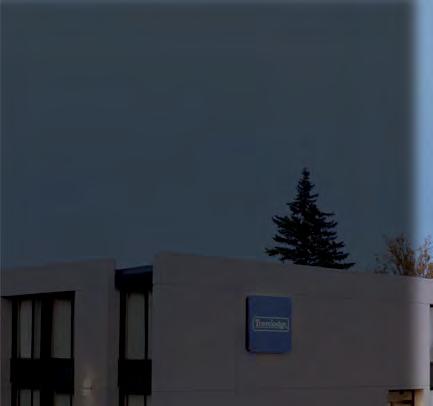

Gregory. “Our programs have inspired incredible brand support and loyalty among pet lovers. Returning and new guests often seek out Kimpton specifically for our pet-friendly policy.”

Cuthbert finds that pet-friendly services trump loyalty points or other perks. “Many could care less what points program we have. If we give each dog that comes in the door a cookie, that guest is sold.”
Connecting with pets is also a nice pick-me-up for staff, she adds. “It’s not unusual for things to stop when a pet arrives at the hotel. It gives us a welcome break during the day. Being able to take a few seconds to greet a pet is a win-win for everyone.” ◆









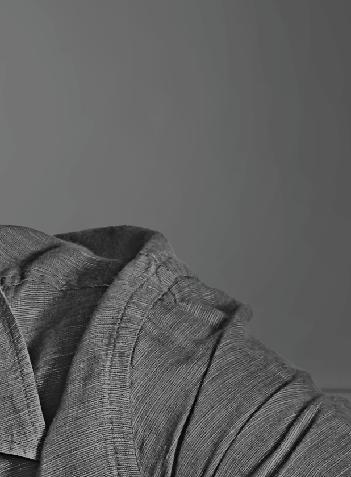








 BY AMY BOSTOCK
BY AMY BOSTOCK

he use of technology was accelerated in hotel operations during the pandemic and now, with myriad challenges still facing the industry, the implementation of new tech to fill the labour gaps and increase guest satisfaction shows no sign of slowing.
But introducing this technology presents its own unique set of challenges.
“The independent hotel industry is often accused of being slow to adopt technology,” says Tymen van Dyl, founder and CEO of hotel-management software provider RoomRaccoon. “Afterall, we’re talking about a high-touch industry that revolves around optimizing the human experience.”

van Dyl says if there is a silver lining from the pandemic, “it’s that it catalysed the adoption of technology among independent hotels that needed to streamline their operations and offer a contactless guest journey to remain competitive.”
That said, the industry as a whole still shows some resistance to digital acceleration, so one of the key factors in designing high-tech for a low-tech industry such as hospitality is making sure it’s intuitive and easy-to-use. “What’s more, an all-in-one solution makes it much easier to onboard new staff as they only need to learn one system,” says van Dyl.
“Introducing new technologies means adapting and changing the way things are done,” says Francis Léonard, CEO, Tip & Go. “At first, employees are generally averse to change. To move to new methods requires changing employees’ mindset and providing training.”
He cautions that new technologies must also be user friendly if hoteliers want clients, especially older generations, to adopt them. “For instance, with Tip&Go (mobile tipping) there is no need to download an app. The client simply scans the QR code with his device to directly tip the employee.”
Employee pushback is another challenge to implementing technology in hotels says Greg Staley, general manager, E-Pro Bot Inc.

“With any technology, there to at times pushback for fear

of losing one’s position. Servers, until trained, are nervous of food-moving robots in a hotel restaurant. However, they quickly learn they are less sore as they are not carrying so much weight at such a distance, they have bigger table bills as a result of better guest attention and upselling, with better service, they also can expect better tips. So, the unknown is scary in the first days, but the staff quickly learn that the robot helps them make even more money for the hotel and for themselves.”
On the guest-facing front, Staley says robots are a hit wherever they’re put into service. “Kids love to see them; most seniors are just fascinated — 78 per cent of the people that see robots are just fascinated, 18 per cent are neutral and four per cent are negative.”

Andrew Rees, corporate account manager, Global Lodging Canada at Ecolab agrees the key challenge hotels face when introducing innovation is training their staff. However, another challenge, he points out, can be a psychological one “where staff may love a new technology that helps them save time, but they get nervous that this technology may potentially replace real people. There are also guests that prefer to deal with a person, regardless of technologies.”
But van Dyl feels the hotel industry is capable of great innovation. “We’ve come leaps and bounds in the last decade, but still have plenty of runway ahead of us.”
He says a growing trend that hotels should have on their radar is automated payments. “Consumers are becoming increasingly reliant on their mobile devices and have come to expect frictionless payment experiences woven into their stay. Hotels that can deliver this are in line to receive big rewards,” he says. “Imagine being able to skip the front desk and settle your bill from the comfort of your room on your mobile device. That’s what we’ve introduced with online check-out. Offering your guests this kind of convenience is key to futureproofing your property and securing repeat business.”
The following Technology Roundtable focuses on digital transformation within hotels — from enhanced cleaning products to robotics — and offers expert insights from tech providers into how your hotel can embrace new technology without losing the human touch.
AMY BOSTOCK: What are the most popular technology trends you’re seeing in the hotel space?
FRANCIS LÉONARD: Contactless guest experiences. Hotels are increasingly adopting mobile check-in/checkout, digital key cards, and contactless payment methods to improve safety and convenience for their guests. AI-powered chatbots and virtual concierges offer personalized guest services and help hotels cater to guests’ needs more efficiently, while Internet of Things (IoT) integration allows smart-room experiences and enhanced energy efficiency to become the norm as hotels integrate IoT devices into their operations.
On the robotics side, housekeeping, room service and luggage handling are being automated with the help of robotic solutions. Data remains a top priority as hotels leverage it to optimize targeted marketing, personalization, and revenue management.
ANDREW REES: Technology has always played a key part in shaping the lodging industry, specifically when it faces challenges. Now, with the labour challenges that the industry faces and the heightened cleaning requirements, technology is there to help. A good example is the kiosk self check-in. Another one is the electrostatic-sprayer technology that helps disinfect large spaces in a very short time.
GREG STALEY: Hotels are moving towards
smart solutions. Rooms are becoming smart, more interactive, and this trend will continue. Clearly, we will have guests that could care less about a QR code in their room to order food or a TV-based menu. Some have not kept up with technology, and their review would be around customer service. However, we are at a place in time now where most guests use and expect technology to be available where they stay. Innovation creates excitement that guests cannot wait to share with others. I was in British Columbia, and my hotel bathroom mirror turned into a TV with just a click of a button. I thought that was the coolest thing I had ever seen; while this was many years ago, I still tell people about it to this day.
AB: What are your hotel clients’ top asks when in comes to technology?
AR: Lodging clients always look for technologies and innovations that help them improve their operations. A major innovation that clients look for are programs that offer water and energy savings, as such programs help the hotel save money while they achieve their sustainability goals. Another example are products with multiple applications such as all-purpose cleaner disinfectant and glass cleaner (three-in-one solution) that help save time and reduce labour.
FL: According to a recent study by Hotel Technology, 73 per cent of guests surveyed are likely to return to a hotel that meets their technology needs, highlighting the significance of technology
in guest satisfaction. Clients seek technology that works effortlessly with their current operations while enhancing guest and employee experiences (i.e., no integration with existing systems is needed) and their guests expect tailored services and smooth, hassle-free stays. Other asks include intelligent TV driven by personal devices along with guest apps and in-room tech, virtual concierge, guest messaging and chatbots, digital checkins and kiosks, and keyless entry. High-speed Wi-Fi is, of course, a must. When it comes to data privacy and security, ensuring compliance with data protection regulations and safeguarding guest information are top concerns for clients.
GS: Guest experience and ROI. How can we improve the guest experience, while also driving our ROI on any new innovation? When E-Pro Bot team members are able to speak with hotel management, we are able to show them how they can generate substantially more income. Simple tasks they miss, also means potentially massive missed revenue. When I show a hotel general manager or owner how they are missing revenue, they are always shocked.
Tymen van Dyl: We specialize in creating hotel-management software for small to medium-sized properties. So. as you can imagine, their needs differ from large chains. Self-service technology, such as smartlock solutions, is becoming increasingly popular among small to medium-sized properties operating with smaller teams. With this
solution, properties can fast-track guests to their rooms without needing a dedicated staff member to manage the front desk, saving hoteliers valuable time and helping create a frictionless experience for guests. This category will become even more popular as guests demand greater control over their stay and
AB: How is your company addressing these demands (i.e. new products brought to the table)?
AR: At Ecolab we help customers reduce utility consumption, optimize labour and improve the life and efficiency of their entire operation. We offer water, hygiene and infectionprevention solutions and services that protect people and the resources vital to life. We deliver comprehensive science-based solutions, data-driven insights and worldclass service to advance food safety, hospitality, long-term care, facilities and on-premise laundry businesses.
FL: Tip&Go has developed cutting-edge products which require no integration to hotel systems, offering scalable and customizable solutions to cater to hotels of all sizes and their housekeepers, concierge and valets. We also prioritize customer support and ensuring compliance with data-protection regulations.
GS: We have hotel restaurant open-shelf or closed-door delivery robots that can bring food from a kitchen to a table or serving area near to a table. This saves servers approximately
According to Greg Staley, general manager of E-Pro Bot Inc., in the next two years, there will be many hotels with robotic solutions for room service, floor cleaners, transport robots and even butler bots that can carry luggage to a room.
“All will be based on smart technology that the hotels employ, with the goal of offering better, faster customer service and the most positive guest experience
50 per cent of their time that is spent just walking to and from the kitchen. In one hotel, the server had a 30 second walk to the kitchen, plus a two-three-minute wait for the food. This means that with 10 tables, that server is off the serving floor for 30 to 40 minutes, plus another 15 minutes to take dirty dishes back to the wash station. Rather than having a server off the floor, let the kitchen send the food to the server. With the walking time eliminated, the server can now focus on guest satisfaction and upselling. If they can sell 15 more drinks, appetizers, or desserts per shift, that’s $120 per day at average prices and $43,800 on the year.
We also have sanitizing robots to disinfect rooms or activity areas. These robots can move autonomously late at night, disinfecting by fogging common areas, or even be put into areas that are closed to engage their UV sanitizing light system. When guests see these robots in action, have a positive feeling that the hotels have high cleanliness standards.
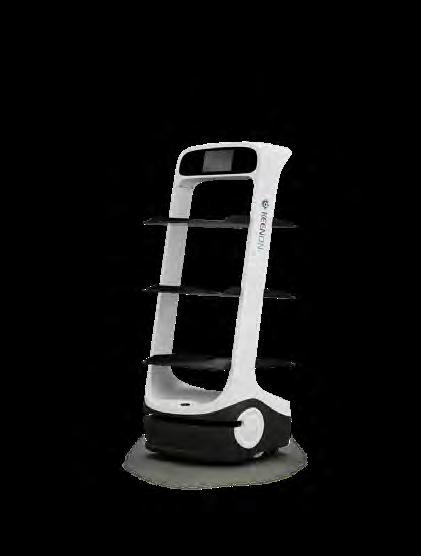
possible,” says Staley. “Technology is coming, and the early adopters will gain in new revenue savings or generation and simply through the number of videos posted of their facility and the positive guest experience. Free Wi-Fi was once advertised by hotels [as a selling feature], but it is now an expectation. Soon new, fun and technological advances will also be expected by guests.”
TV: The hotel tech industry remains highly fragmented. This can be intimidating for operators and, more often than not, keeps them from innovating. At RoomRaccoon, we strive to offer an intuitive, out-thebox solution that provides everything hotels need to thrive. That means we’re constantly innovating. In the last year, we have launched a number of new native tools such as our advanced housekeeping-management module, online check-out and digital ID scanner that help hotels automate reoccurring tasks to alleviate the workload on staff, and ultimately allow more time to improve the guest experience. We also offer an integration marketplace where hotels can customize their tech stack with their favourite tools, and run them from one interface. This marketplace is constantly growing. Take smart locks, for example. To cater to the growing demand, we have enabled our system to integrate with popular solutions like FLEXIPASS, Salto, Assa Abloy, NUKI and more.
AB: What are the top two technology solutions you think hotel operators should be focus on?
GS: Service is very important in the hotel industry. Some hotel guests still oppose human contact, and robot use is a comfort to them. A guest must enjoy their stay and will remember and tell others about a bad experience, a positive experience or a neat experience. Our robots create a fun experience and many of your guests will take photos or video with or of our robots. If only 15 guests per day take and then post a video on their social media, and if they have only 100 followers, that is 1,500 geo-located video impressions of your facility a day. Every day if this happens, that would be half a million videos per year or, as we say, the side benefit of free marketing for your facility.
AR: Hotel operators should focus more on their customer’s satisfaction, so need technologies that can
help them optimize their internal operations, that reduce labour, save water and energy and improve their guest’s experience.
FL: Hotel operators should focus on implementing contactless and mobile technologies that enable guests to check-in, access their rooms, order services, make payments, and tip without physical contact with staff or shared surfaces. This can enhance safety, convenience, and efficiency while reducing costs and enhancing guest and employee satisfaction. Thy also need to leverage data analytics and businessintelligence tools to gather, analyze, and act on data from various sources such as guest feedback, social media, booking patterns, client satisfaction and operational metrics. This can help operators to identify trends, opportunities, and areas for improvement, optimize pricing and revenue, and enhance the overall guest experience.
TV: Implementing a dynamic pricing strategy can be
super time-consuming and complex without the right technology. The truth is, demand in the hospitality industry constantly fluctuates. So, selling time-limited inventory such as hotel rooms at a fixed price year-round is a common mistake that costs hotel operators thousands in lost revenue. This is something that hotels simply cannot afford in today’s economic climate. Luckily, there are several accessible solutions on the market that simplify this process [by providing] automatic rate updates that maximize revenue according to demand.
AB: How does your technology help address the ongoing labour challenge in hotels?
FL: The hotel industry is currently experiencing serious staff shortages. Knowing that a third of hotel workers won’t be returning to the industry because they want higher pay and that a mobilepayment option increases tips significantly (by 30 per cent or more), then it flows that offering a tipping solution makes a lot of sense.
In addition, technology can help address the labour challenge in hotels by automating routine and repetitive tasks, freeing up staff time for higher-value activities such as guest engagement, problemsolving, and creativity. As well, technology can help to bridge skills gaps and enable staff to access training and development opportunities through online platforms and virtual-reality simulations.
GS: There are a couple of measurable ways to look
at this. Some hotels have stopped room service as a result of COVID. We can bring room service back in those locations with our room-service robots. Some places have a major issue with staff. If short-staffed in a hotel restaurant, the remaining staff can handle more tasks if we are able to take away 50 per cent of the walking part of their jobs. If staff is not an issue, all staff have more time to focus on the guest and drive revenue through upselling. If the staff challenge is porters or the ability to deliver to room, our room-service robot can fill in the void — especially during slow times when it is difficult to balance too much staff versus not enough with a sudden unexpected spike. Robots can be used throughout the hotel, from restaurant, to room, to moving laundry to specific banquet service.
AR: Technology can allow hotel staff to do more with less time. An example is the innovative disinfectants that have shorter contact time, which can help the housekeeper clean a room faster, hence cleaning more rooms per hour. Another example is disinfectants that
can use the electrostatic spraying technology, where a housekeeper can disinfect a large room in seconds.
TV: One of the lingering impacts of the pandemic is certainly the industry-wide staff shortages. Although this wreaked havoc on the industry, it did encourage hotels operating on skeleton staff to re-think how they could increase efficiency by using technology to automate time-consuming tasks. The future of hospitality will see a stronger synergy between technology and people. As intuitive technology becomes more accessible, hoteliers will be more comfortable with running predictable, repetitive, obvious operations on autopilot, while freeing up hotel staff to pamper guests and deliver a five-star experience.
AB: What advice would you give hoteliers to help them navigate the digital transformation of their operations?
GS: My favorite quote is “if you always do what you’ve always done, you will always get what you always got, until somebody takes
it from you.” This just means if you do not evolve, others will. If the industry is moving towards smart rooms, technology and now autonomous robots and you do not, guests will follow the technology as it creates excitement and comfort.

AR: Do your research, but don’t get left behind. Technology is now looping itself every three-tosix months with newer applications and updates.
FL: Focus on the specific needs and preferences of guests, staff, and business objectives. This includes conducting thorough research, developing a clear strategy, and prioritizing investments based on Return on Investment (ROI) and guest-experience impact. Additionally, it is essential to ensure that any new technology is user-friendly, integration friendly, and secure, with a clear plan for staff training and support.
TV: It’s important to partner with a supplier that guides you through the complexities of adopting new technology. ◆
AS TECHNOLOGY evolves and labour shortages and rising costs continue, hotel kitchens are undergoing a transformation. As a result, operators are now re-thinking kitchen design when making equipment choices.

Many wish lists now include advanced, intelligent, multi-functional systems that can work quickly, reduce space requirements, deliver consistent results, and keep staff numbers at a minimum.

“All full-service hotel production kitchens have shrunk remarkably over the years,” says Rob Hood, corporate director, Food & Beverage, Silver Hotel Group in Mississauga, Ont. “In many places, the banquet kitchen has been absorbed into one production, storage and service space.”
With 22 various brand properties, Hood says there are no cookie-cutter plans for equipment investments. “Every scenario has different equipment demands. At the same time, we are looking at technology development and multi-functional items.”
According to Hood, one of the most significant innovations is ventless cooking technology. “Equipment pieces that don’t require external ventilation allow even the select-service environment to steam, roast and bake products in very quick order using a very simple technology. Ventless is even making its way into frying systems and cooktops. You can build an entirely ventless kitchen, as long as you have water and drainage, which cuts down the costs.”
Alto-Shaam’s Vector is another innovation that has changed the small-oven dynamic as it allows a full combi setup in a compact unit, is completely ventless and includes zone cooking, says Hood. “And it fits in a
3’ by 2’ footprint, allowing major production to take place in a very small kitchen.”
Recently Hood has also been working with blast chilling. “Blast chilling and combi-oven technology really go together hand in hand. Chillers have evolved from large and expensive walk-in large formats into undercounter units. This allows even smaller operators to prepare food products for later re-therm, save time, and use batch cooking much more effectively.”
For Ernesto Castillo, director of Food and Beverage for the InterContinental Toronto Centre, much of his focus has been on labour savings and versatility. “The middle of last year, it was hard to find people. The second half was hard to find ingredients for our menus. One thing we learned quickly was that we needed to streamline processes as much as possible.”
With regard to replacing old equipment, “We look at anything that helps us do things better and make it easier on our kitchen staff. For example, we had three small pizza ovens that did the job but needed replacing. We found a [Lincoln] conveyor oven that was a bit more expensive, but now we can make perfect pizzas in about four minutes.”
Castillo also purchased AIR 2.0 chocolate tempering machines from Perfect Choco. “We can manage tempering without using up the hours we used to doing it by hand. Those two machines have definitely helped us save on labour.”
To help on the supply
front, Castillo acquired a Commercial Urban Cultivator for growing basil and other garnishes. “We’re taking full advantage of the system now. It makes it easier to have control over our menu items.”
Luckily for Castillo, the kitchen acquired new Rational combi ovens just before the pandemic. “We had just started playing with them before the lockdowns. They were life savers. I can go to the screen, pick what I want to bake, it will automatically do it. They pretty much do everything by themselves. They’re so intuitive we’re looking to buy another this year.”
Moving forward, Castillo says he is looking for technologies that are more intuitive. “Some equipment you can’t change – a griddle is a griddle after all. But the more equipment you can use to save labour, that’s the name of the game.”
Eraj Jayawickreme, director of Culinary at Fairmont Olympic Hotel in Seattle, has recently invested in a number of
updates as part of the hotel’s multi-million-dollar lobby renovation. These include French flattops, combi ovens, pasta extractors, a blast chiller, blanching equipment, and pull-outdrawer style refrigerators with work surfaces. Still to come: two new Rationals, and induction technology for its banquet operations. “We’re more on the path of re-therming and preparing [food] ahead of time versus line plating. We don’t have
the hands for that.”
The bakery was a major investment focus, where acquisitions include a 200 qt. spiral mixer, an updated proofer, and stand mixers. “The pastry shop is a big spend this year,” says Jayawickreme

And for the kids and young at heart, they invested in a self-serve ice-cream machine and cotton-candy maker, “just to have fun,” he adds.
“Technology has grown by leaps and bounds,” says
Jayawickreme. “It’s more about adapting processes for getting things done versus simply getting equipment.” An integral part of that is moving to Bluetooth and Wi-Fi based communications.
Whatever the technology, understanding what you are paying for is key, cautions Hood. “When combis first made it big, everyone bought them, but didn’t understand they were not just an oven. It’s like buying a Ferrari. If you don’t know how to drive it properly, you’ve wasted your investment.”
With all the innovation at hand, Hood contends the real advancements are in the quality of the food these items are now producing. “As good as equipment is getting, the actual food itself is improving. It wasn’t always that way. We finally have a great marriage of technology and food quality. Now you can create amazingly impactful menus in very small spaces, and you don’t need a certified chef de cuisine to be able to do it. That’s the brilliance of what technology has come to.”
Select-service kitchen spaces have become smaller than ever, with storage, food prep and production existing in a 250 to 500 sq. ft. room, says Hood. “One of the most exciting innovations that has arisen in select service is that what used to be a croissant, orange juice, and tea or coffee, has evolved to include one or two protein items with fresh-baked pastries.”
IHG’s newest avid brand launched its first hotel in Vaughan, Ont. this past year. A comfort priced offering, it has completely re-invented the “hotelkitchen” concept, creating a round breakfast display of grab-and-go breakfast items with rotating hot handheld options.
“Since we have no formal area for breakfast, we set up a Beacon each morning that looks like a piece of pie for easy access to items,” says Bonnie Anderson, general manager. With minimal space, the kitchen area is equipped with a small convection oven to produce vegetable regular breakfast style sandwiches. “One attendant is all we need. It really does help elevate midscale market breakfast service.”

No longer an afterthought, the hotel bathroom has become a design focal point. Whether that means maximizing the efficiency of a smaller space or cutting into old closets to augment the floor plan, designers are delivering new looks to an old concept.
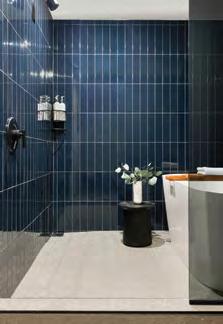
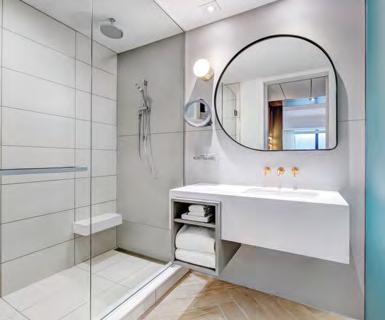



“Hotel guests spend a lot of time in the bathroom, so it’s important to make the space unique and memorable,” says Adèle Rankin, principal and global design lead at CHIL Interior Design. “White became the standard colour for bathrooms simply because it can make a small room feel large and it’s easy for people to see that it’s clean.”
Now Rankin says that design is veering away from simple whites and subway tiles in order to deliver a more eye-popping experience for guests. “We’re really looking to deliver that ‘wow factor,’ because if the bathroom doesn’t shine, the whole experience of that hotel suite will be tarnished.”
Rankin notes that CHIL will often sacrifice some of the bedroom space to make the bathroom moment that much more impressive. “As soon as you swing that door open to the bathroom, everything is on display,” says Rankin. “So you really want it to be a memorable moment because that’s what’s going to be remembered by the guest.” Important features for bathrooms, according to Rankin, include a proper shower set-up with a shower wand and rain head inside a stall with ample space: “You want to make sure that if you are that 6' 4" tall man, that even he feels

comfortable — not squished in.”
At the Ottawa-based Fairmont Chateau Laurier, CHIL fashioned a dramatic bathroom in the Karsh presidential suite. “This place is bigger than some people’s apartments,” laughs Rankin. “But it reflects the luxury of a Fairmont in its grandness and opulence.” Rankin says the design team chose to cut into a heritage walk-in closet that never got used in order to create a giant bathroom with a shower big enough for two people.

For CHIL’s re-design of the Richmond, B.C.-based Versante Hotel, Rankin notes that “the bathrooms are the heroes of this hotel” in terms of their playfulness with the design. Examples of this include a multiple guestroom bathroom with a wet room and free-standing tub against a window wall.
Beyond the guest suites however, Rankin also says it’s
important to conceptualize public bathrooms, such as those near the lobby or a ground-floor restaurant space. At the Versante, CHIL created a unisex, oval public bathroom with Chinese red lanterns on the ceiling and black marble as a featured material around the free-standing sinks. “It’s like nothing you’ve ever seen before,” says Rankin. “This bathroom is a true original.”
While some hoteliers are expanding their bathroom footprints, others are finding design solutions within the constraints of less space. “We work in a lot of hotels where the bathroom footprint is getting smaller,” says Stanley Sun, co-founder and creative director at the Toronto-based Mason Studio. “But that’s an opportunity for us to get more bold.” Stanley says he might use a deeper colour of paint such as maroon or a warm beige — though it must
be a colour that makes the skin “glow”.
At the Andaz Ottawa Byward Market by Hyatt, Stanley said he kept the bathrooms simple, but created interest through the wood porcelain tiles. “There are so many incredible options in porcelain, the most operationally efficient material out there,” says Stanley. “I just came back from a fabricator in Italy who specializes in new technologies and what they are coming out with is so cool.” With innovative manufacturing processes, virtually any high-resolution image can be transferred to porcelain these days.
While some operators still opt for the classic white look, Stanley says he re-invents classic bathroom layouts by re-configuring the basics. “Something we’ve been doing recently that has been very well-received is using traditional materials in new ways,” he says. “Everyone is familiar with a subway tile or a carrara marble, but we modernize it in a way that makes people think ‘oh I could have done that’. Examples include putting a more graphic pattern into a subway tile, stacking them vertically or creating an unexpected pattern with them.

Stanley says that the trend towards the micro-hotel has also created some unique design challenges. “We’re working on one right now and are actually re-imagining it with the glass block,” he explains. “It’s an old material that was used in bathrooms in the ’80s, but we are bringing it back to bring more natural light into the space.” Stanley says he also uses it in shower stalls. Mason Studio also placed the sink outside of the bathroom as there was no room for it within.
In tiny bathrooms, Stanley insists that keeping the space minimal is key. “You don’t want to clutter up the space with non-essential features,” he says. “Carefully placed mirrors can also provide the optical illusion of more space.” At the Toronto-based Kimpton Saint George, Stanley explains that they had to get creative with the smaller bathroom spaces: “We put the mirror sort of askew and also introduced lighting on the mirror — so the whole design almost looked like a broken make-up mirror.”
At the Kimpton, Mason Studio also played with the position of the bathtub, placing it directly inside the shower as a free-standing fixture. “It’s something that brings a smile to someone’s face,” says Stanley. While some hotels, such as those catering specifically to a business demographic, might do away with bathtubs, Stanley says the fixture is here to stay: “You are accommodating a wide variety of people and you never really know who your guest is going to be,” he says.
Both Stanley and Rankin agree that lighting has become more consciously outfitted in hotel bathrooms. “ People are becoming more aware of good and bad lighting,” says Stanley. “So for us it’s about creating as much reasonable flexibility as possible in terms of types of light.” Stanley says there would first be a general ceiling light for the day-to-day tasks, but then an essential sconce on the glass for someone putting makeup. Designers are also creating a low-level lighting under the vanity for a more ambient look.
No space is too small for high-end design. ◆


Ever since he was a young child growing up in India, the hotel industry has fascinated Hiren Prabhakar. The love affair was fuelled by his parents who exposed him to travel from a young age. By the time he had to decide which career path to follow, the native of Mumbai, decided hospitality was his calling. “The Oberoi School of Hotel Management, now called Oberoi Centre for Learning & Development campus, recruited me from university,” explains the GM of Toronto’s St Regis, adding he “did a two-year full-time post-graduate program in hotel management.”
The hotelier left India to work in Dubai on the pre-opening team at the iconic Burj Al Arab and started out as a Management Trainee at the Oberoi New Delhi. “This was where I learned the foundational aspects of hospitality. I enjoyed creating the entire luxury guest experience.”
Prabhakar joined the elegant St. Regis Toronto in July 2022. “The property is unique for many reasons. We have an incredible opportunity as the first St Regis in Canada. Its legacy, history and rituals (butler service, champagne sabering, signature cocktails, afternoon tea and midnight suppers) are legendary but new to Canada, so it’s exciting to be a part of the team to bring it to life here in Toronto.”
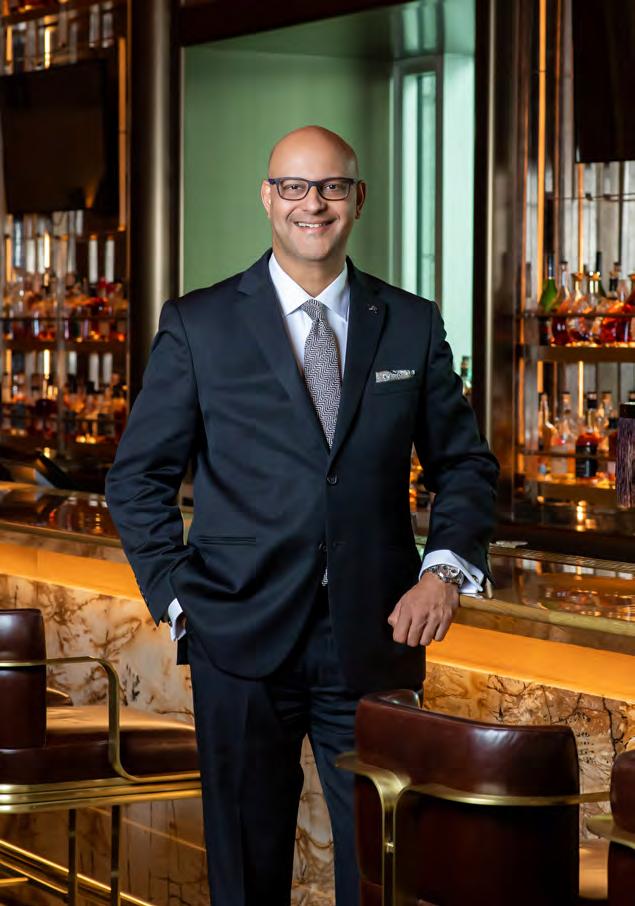
Along with his team of 335 associates, the collective mission of the hotel is “to make the everyday exquisite for our guests by empowering our hosts to make the ordinary extraordinary.
While there was no roadmap to deal with the pandemic, the father of one son says his biggest learning was to stay positive and have faith in the future, and to take care of teach other during difficult times. “I learned to appreciate what we have and enjoy the freedom of travel and to connect with people without restrictions.” He’s happy that recovery has been quicker than expected. “In 2022, we exceeded 2019 average room rate by more than 30 per cent. Credit goes to InnVest Hotels for fully renovating our hotel, and the power of our brand.
As the pandemic now fades into the rear-view mirror, Prabhakar is focused on being the “Number-1 luxury hotel in Canada by continuing to elevate our service and experience.” Earlier this year, the hotel was named as a Double Five-Star Hotel & Spa by Forbes Travel Guide The hotel is one of two in Toronto and one of four in all of Canada to receive this prestigious honour. “Our goal is to maintain our Double Forbes Five-Star status and continue to set the luxury benchmark in Canada.”
To this end, Prabhakar believes it's the associates that "will always set us apart with the passion, energy and magic they bring to their work. We need to be intuitive and a step ahead of guests needs to be considered luxury — we need to wow a guest; this isn't easy, but it's what St. Regis Hosts do best” ◆
Define your style?
I have a lot of passion for what I do and I’m fully committed to put the needs of our associates first and help people develop while leading them to perform at their best.
In line with our mission, our philosophy is to make the everyday exquisite for our guests by empowering our Hosts to make the ordinary extraordinary.
What keeps you up at night? Thinking about how we can be authentic and make sure every guest experience is exquisite and how we can increase the guest's intention to come back again










Check out the Checking In podcast to listen to conversations between editor and publisher Rosanna Caira and hotel industry leaders speaking about the issues impacting the dynamic hotel industry.





E40. GROWING THE BRAND MARK WILLIS CEO | FAIRMONT HOTELS & RESORTS WORLDWIDE YIGIT SEZGIN CHIEF BRAND & COMMERCIAL OFFICER | FAIRMONT HOTELS & RESORTS WORLDWIDE




E39. BUILDING ASSETS GEOFF ALLAN PRESIDENT | PROJECT CAPITAL MANAGEMENT

E38. THE PATH TO SUCCESS ROBIN MCCLUSKIE COLLIERS INTERNATIONAL CARRIE RUSSELL HVS REBECCA GODFREY CBRE


E37. THE ART OF HOSPITALITY ROCCO BOVA FORMER HOTELIER & INTERNATIONAL CONSULTANT


CHECKING IN podcast episodes are available at hoteliermagazine.com/category/media/podcast/ or find them on and
